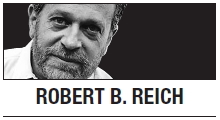Four years into a so-called recovery and we’re still below recession levels in every important respect except the stock market.
A measly 88,000 jobs were created in March, and total employment remains some 3 million below its pre-recession level. Labor-force participation is at its lowest level since 1979.
The recovery isn’t just losing steam. It never had much steam to begin with.

That’s because so much of our debate over economic policy has been beside the point.
On the one side have been Keynesians ― followers of the great British economist John Maynard Keynes ― who want more government spending and lower interest rates in order to fuel demand.
We tried a big Keynesian stimulus from 2009 to 2011, and the Federal Reserve is still keeping interest rates near zero.
I side with the Keynesians. But let’s be candid: Keynesians don’t have a clear answer for how much additional government spending is necessary in an economy, like ours, in which wages keep dropping. Simply urging “more” isn’t convincing.
On the other side are supply-side “austerics” who want lower taxes on the wealthy and on corporations to boost incentives to hire and invest, and who see government deficits crowding out private investment.
They’ve won the latest round by making the Bush tax cuts permanent for 98 percent of taxpayers, hiking Social Security taxes back up, and implementing the so-called “sequester” cuts in the face of stubbornly high unemployment.
But supply-side austerity doesn’t work. George W. Bush tried supply-side tax cuts for the wealthy in 2001 and 2003, and nothing trickled down. In fact, job growth slowed and real wages declined.
Austerity economics, meanwhile, has proven a disaster in Europe. Slashing public budgets when unemployment is high and demand already weak has been shown to be a recipe for recession ― making public debt even larger relative to the size of the overall economy.
Both sides of the modern debate have neglected the economic elephant in the room: the scourge of widening inequality.
When all of the economic gains go to the top, the rest of the population doesn’t have enough purchasing power to keep the economy going. We should have learned this after 1928, when the top 1 percent got more than 23 percent of total income. The following year, the economy collapsed. The next time the top 1 percent got more than 23 percent of total income was 2007.
Businesses won’t hire and expand unless they have more customers. But most Americans can’t spend more, and net exports can’t possibly make up the difference. That’s why retail sales were down 0.4 percent in March and consumer sentiment has fallen to its lowest level in nine months.
The vast middle class is running out of money because real annual median household income keeps falling. It’s down to $45,018, from $51,144 in 2010.
All the gains from the recovery continue to go to the top.
The Obama administration is urging banks to lend more. But with declining incomes, the middle class can’t borrow more ― and shouldn’t, given what happened after the last borrowing binge.
So one important way to get the nation back on track to is to restore middle-class prosperity and reverse the trend toward widening inequality.
The Great Depression finally ended with the massive Keynesian spending of World War II. The economy continued to expand after the war because of policy changes in the 1930s that reversed widening inequality and spread the benefits of growth: collective bargaining, the 40-hour workweek, the minimum wage, Social Security, and then, after the war, wider access to higher education.
What can be done now to reverse widening inequality?
First, award tax cuts to companies that link the pay of their hourly workers to profits and productivity, and that keep the total pay of their top five executives within 20 times the pay of their median worker. And impose higher taxes on companies that don’t.
Raise the minimum wage to half the average wage, and expand the Earned Income Tax Credit.
Increase public investment in education ― including early-childhood education. And allow college students to repay the cost of their higher education with a 10 percent surcharge on the first 10 years of income from full-time employment.
And pay for all this by adding additional tax brackets at the top and increasing the top marginal tax rate to what it was before 1981 ― at least 70 percent.
Even the rich would do better with a smaller share of a rapidly growing economy than with a large share of one that’s barely growing at all.
Our political leaders in Washington have for now chosen supply-side austerity economics over Keynesian economics. That’s bad enough.
Their inability or unwillingness to do much of anything about widening inequality will prove a larger error.
By Robert Reich
Robert Reich, former U.S. secretary of labor, is professor of public policy at the University of California at Berkeley and the author of “Beyond Outrage,” now available in paperback. He blogs at www.robertreich.org. ― Ed.
(Tribune Media Services)








